When I started kayaking several years ago, my dad was practically always there to help me improve my skills. Once I had gained enough experience, it was time to stand on my own two feet. But like many others, I was wondering if and how it’s possible to kayak alone safely.
So not a long time ago, I did some research to make sure my solo paddling trips were as safe as they could be. Now let me share with you everything I’ve learned. It might help you enjoy kayaking alone without increasing the risks involved too much.
Is It OK To Kayak Alone?
With proper gear and preparation, you can kayak alone. It’s less safe than in a group, but solo paddling has other benefits. Some people prefer being on the water alone, and there is no problem with that. As long as you have the proper maneuvering and recovery skills, it’s OK to kayak on your own.
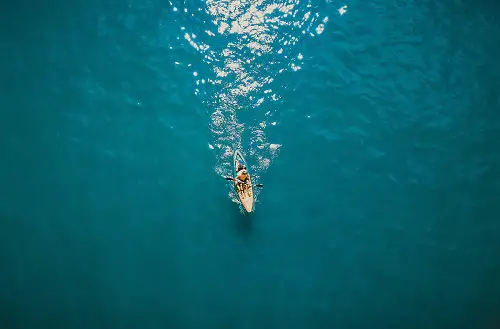
Said like that, it might seem easy. Yet, there are many challenges to practicing this sport without any partner. Most kayak teachers will even advise their students never to paddle alone.
Although it’s better to go kayaking with someone else, solo adventures can still be fun and safe. That’s why I disagree with the preceding statement. I wouldn’t recommend beginners to paddle alone, but more experienced kayakers can do it safely to some extent.
I do it quite often, and I’m still in one piece. (Don’t worry, I just knocked on wood!) So I think solo paddling adventures don’t have to be dangerous, and I enjoy them a lot. If you want other people’s opinions on kayaking along, you can read this thread on Reddit.
Pros & Cons Of Kayaking Alone!
It’s essential to understand what you are getting into before getting started. Paddling solo has a lot of advantages and drawbacks you shouldn’t neglect. So here’s an overview of what to expect while kayaking alone.
My principal concern is that you won’t have anybody to help if you get in trouble. Even people with years of experience and excellent skills can make a mistake. That’s why having someone in back up to give you a hand can literally save your life.
Although solo kayaking is more dangerous, it’s good to develop autonomy and self-sufficiency. If you head out into the water alone, you have no choice but to do everything yourself.
So you will need to plan your trip, transport your boat, launch it, keep you from capsizing, and get back to your car without anyone’s help. After such an experience, you will be much more proficient and confident for your future paddling adventures.
It’s also fun and relaxing to kayak alone from time to time. You can do whatever you desire if and when you want it. Being on your own in the water is almost therapeutic for me.
Some people prefer to paddle without company. Once you don’t rely on others anymore, you will be free to do what you want and ready for solo adventures. Now let’s sum up the good and the bad of kayaking alone.
Pros
- Get To Know Yourself.
- Enjoy Nature More.
- Increased Freedom
- Gain Experience.
- Improve Autonomy & Confidence.
Cons
- More Risks Involved.
- No Social Interaction.
Are You Ready For Solo Kayaking?
Whether you want to give it a try or there’s no one available to keep you company, heading out into the water alone is an option. However, paddling alone isn’t safe for everyone.
There are some conditions you should meet to consider such an adventure. You must have the right skills and gear to kayak on your own safely. It includes…
- Self Launching & Landing Skills. (Getting In & Out Of The Kayak)
- Mastering A Self Recovery Technique. (In Case You Capsize)
- Paddling Skills. (For Control During Navigation)
- Understanding Of The Environment. (Water, Risks, Weather, Etc.)
- Basic Equipment. (Kayak, Paddle, Etc.)
- Safety Gear. (PDF, Helmet, Etc.)
- Communication Device. (Radio, Cell Phone, Etc.)
If you have none of those above, it’s not a problem. My goal is to help you develop the kayaking skills and find the accessories you need to paddle alone.
Most equipment mentioned in this list above is also necessary for group paddling trips. Nonetheless, you might not be the person that has to carry everything. For solo kayaking, you deal with all the gear yourself.
There’s no secret to getting better at something. You must practice. At the start, you should paddle with others to improve your skills and get help when you need some.
Once you meet all the conditions and feel ready to stand on your own two feet, it’s time to kayak alone. But for now, you probably still need to prepare for such an adventure.
How Do You Kayak Alone?
There are several different ways to go paddling on your own. In general, the process is almost the same as in a group. However, you will have to do everything yourself without any help.
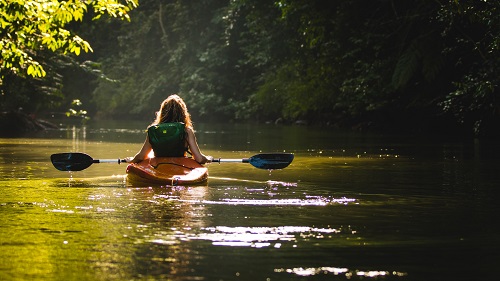
First of all, I’ve divided the solo kayaking trip into four main parts. You will have to plan your day out, launch your boat, paddle along, and get out of the water. Here’s how to do each step of the process correctly.
Preparation.
As for any other trip, planning is essential to avoid problems. Kayaking alone requires a lot of preparation because it involves both equipment and logistics. Without either of them, your paddling adventure can quickly turn into a disaster.
Gear Up For Kayaking Alone.
You foremost have to find the right kayak for your needs. There are different types and models, so it’s essential to ensure your boat is appropriate and safe for a solo trip. For example, you shouldn’t use a tandem kayak to paddle alone. (Here’s why!)
Then, you also have to find the right equipment. What you need will depend on many factors, such as the type of environment, weather forecast, and length of your trip. Here’s a nonspecific gear checklist to ensure you don’t forget anything.
- Kayak.
- Paddle.
- Personal Flotation Device.
- Bilge Pump.
- Spray Skirt.
- Helmet.
- Dry Bag.
- Whistle.
- Radio/Cell Phone.
- Proper Clothing.
Other pieces of equipment like a spare paddle, repair kit, and paddle float can also be helpful on the water. However, it doesn’t apply in every case. Whether you’re kayaking alone or with a group, the list above should be a good starting point.
Plan Your Solo Kayak Trip.
Once you have all the gear you need, it’s time to organize your paddling adventure. First, you have to decide where you want to go. In the beginning, it’s safer to choose a place you know well.
You should also determine when to start, if you take breaks along the way, and at what time you will be back to land. Then, you will have to look at the weather and pack your clothing according to it. Before you go, complete the final preparations to make sure you’re all set.
Know How You Will Get Back To Your Car.
If you’re kayaking in a lake or the ocean, the return shouldn’t be a problem unless you get lost. You only have to go back to where you launched and carry your kayak in your car.
For rivers, it’s a little bit more tricky. Most of the time it’s not possible to get back to your starting point. So, you have to figure out something else. Here are some ways to go kayaking alone in flowing water.
You can paddle upstream and then let yourself cruise down to the starting point or vice-versa if the current is slow enough. When the river is too strong to kayak against the current, you will have to find a shuttle or another way to get back to your car.
One method you can use is to drop your paddling equipment at the starting point and drive your car to where you plan to exit. Then, you can take a bike to get back where your stuff is to launch your kayak. It requires some logistics and preparation, but sometimes you have no other choice.
Solo Kayak Launch.
Now that you have a plan and you’re ready to go, it’s time to pack everything in your boat. Loading the gear evenly from side to side and back to front is essential. Otherwise, your kayak won’t be stable, and you’re more likely to capsize.
Once all your equipment is stored, you still have to get in your kayak alone. It’s generally not too hard, but you must know how to do it. Some techniques will allow you to launch effectively and safely without any help.
How To Get Into A Kayak By Yourself?
Launching from the beach or anywhere the shore is almost even to the water level is relatively simple. You can hop into the boat when its rear part is still on land for better stability. Once you’re inside the kayak, you will have to push yourself in the water and start paddling.
Launching from a dock is more complicated whether you’re alone or not. You have to place the boat parallel to the structure, put your feet in the kayak, and use the dock to lower yourself in a sit position. It’s also essential to place your paddle close enough so you can reach it once you’re aboard.
Another environment you might have to launch from is rocks. In this case, you should put your kayak in the water parallel to the shore. You then have to place your paddle flat with one blade on the rocks and the other on the boat behind your seat. After that, you can use the center of the paddle to stabilize yourself while getting in the kayak.
Depending on what type of terrain you will launch, it’s essential to master the appropriate method. Therefore, you should practice getting into your kayak in various places and situations. It’s the best way to avoid falling in the water right at the start of your trip, which isn’t fun.
Navigate Alone. (Paddling & Recovery Skills)
The real adventure starts when you’re in the water, ready to kayak. It’s now time to put your skills into practice. During solo adventures, your safety will rely on two elements you can develop:
- Your Ability To Maneuver The Kayak.
- Your Capacity To Recover From A Capsize.
Paddling Skills.
It’s essential to have some navigation experience to kayak alone safely. Without reliable control over your boat, you won’t be able to go where you want on the water. That’s why knowing how to paddle accurately is a prerequisite to solo adventures.
Basic maneuvering skills can help you avoid dangerous sections and many other risks. You should know how to move forward, backward, and sideways. Otherwise, kayaking alone won’t be fun nor safe for you.
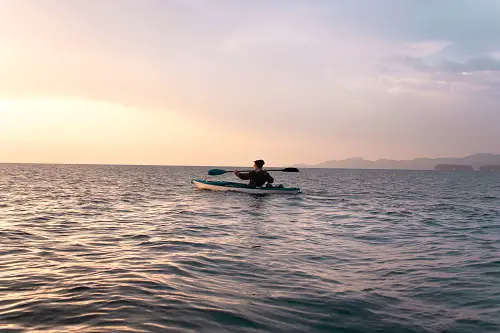
More advanced paddling skills like the low and high brace can also be convenient to prevent you from capsizing. You should avoid tipping over as much as possible, especially when you’re alone.
Improving your ability to maneuver and stabilize your kayak will prepare you for solo trips. When you’re in a group, it’s time to practice your paddle strokes and ask for some help if needed. Because on your own, you will have no other choice than to rely on yourself only.
Kayak Recovery Techniques.
Whatever experience and skills you have, someday you will flip over while kayaking. If it happens when you’re alone, you must know how to react. The last thing you want is to get stuck in the water having no idea of what to do and nobody to help.
Therefore, you should learn to recover from a capsize alone before considering solo paddling adventures. Being able to get back into your kayak reliably is essential to avoid problems on the water.
It’s not too complicated, but you still need to understand the process and practice quite a bit. First of all, you must remain calm when you fall in the water. Otherwise, you won’t be able to think clearly.
Then, you have two options of kayak recovery techniques to choose from according to your skills and the situation. You can either roll or perform a wet exit. Let’s see what they consist of and how to master them.
Wet Exit.
The first technique is the wet exit, in which you will have to get out of the kayak under the water. It’s easy to learn, but it still requires a little bit of practice to do it smoothly and reliably.
Every paddler should know how to perform a wet exit because it’s a fundamental kayaking skill. Whether you plan to kayak alone or in a group, you should work on this technique before heading out on the water.
Here’s how to do it.
- Lean Forward.
- Slide Your Hands Forward On The Spray Skirt.
- Find The Grab Loop & Pull It.
- Place Your Hands On The Kayak Cockpit.
- Bend Your Knees Together.
- Push Yourself Out Of The Kayak.
- Let Yourself Float Back Up To The Surface.
If you’re in a sit-on-top kayak or don’t wear a spray skirt, you might fall off the boat as it flips. Thus, you won’t have to perform the wet exit in such circumstances. But you still have to find a way to get back upright and ready to paddle.
Once you’re in the water beside your kayak, you have two ways to recover from your capsize. You can either swim back to the land and relaunch or flip it over on the right side and do a self-rescue. But in certain situations, you won’t have any choice.
For example, whitewater kayaks or any other model without hatches to keep the boat afloat will sink over the cockpit if you get back in it when it’s full of water. So swimming to the shore will be more appropriate in this case.
Self-Rescue.
The self-rescue technique is more appropriate in open waters such as the ocean. It consists of turning over your capsized kayak, setting up your paddle float, using it as an outrigger to get on the boat, and sliding into the cockpit.
You can then empty the water from your kayak with a bilge pump and continue your trip. The wet exit is easy to learn and ideal for beginners. But there’s a more convenient alternative to recover from a capsize.
Roll.
The second method to get back upright when you flip over in a kayak is to roll. It’s a technique used by more advanced paddlers to recover quickly after capsizing. You will need a lot of practice before mastering the roll, but it’s a game-changer.
If you’re serious about getting into kayaking, I highly recommend working on this convenient skill. To give you an idea of how to work, you have to place your paddle in a specific position to use it for momentary support.
You can then perform a stroke of hips to make your kayak turn over in the right way. Don’t rely on your arms and paddle stroke. Working on the movement of your hips and keeping your body at the surface is what matters the most.
Once you have improved your paddling and recovery skills, you’re ready for solo adventures. It’s essential to prevent you from capsizing and know what to do if somehow it happens. Without any significant experience, kayaking alone isn’t safe.
Self Kayak Exit.
There’s one last small thing you should know to end your solo paddling adventure the right way. It’s how to exit a kayak by yourself. Depending on the boat design and environment, getting out of it can be more complicated than getting into it.
However, the process is relatively straightforward to understand. You often have to place your kayak parallel to the coast, use your paddle for stabilization, and step out one foot at a time to keep your balance.
If you can slide your kayak tip on the land (sand or grass) and it’s not too deep, you should do it. Then you will be able to exit by getting your two feet out on each side of the boat.
So this is how a solo paddling trip should go and all the skills you should have to do it safely. With some preparation and practice, I’m sure you can do it. Just make sure kayaking alone isn’t too dangerous for you.
Tips For Kayaking Alone Safely!
Although practically anyone can do solo adventures, you should know many things to paddle on your own safely. By taking a few precautions, you can drastically reduce the risks involved. Thus, here’s what every kayaker should consider before heading out on the water alone.
Paddle In The Right Water Conditions.
Not every environment is safe for kayaking by yourself. You should always find an appropriate spot for your situation. So a calm lake would be ideal for people that don’t have a lot of experience and want to paddle alone.
Getting started right away in whitewater and technical rapids won’t be fun nor safe. You should know your limits to kayak alone safely. Being familiar with the area is also essential to avoid potential dangers.
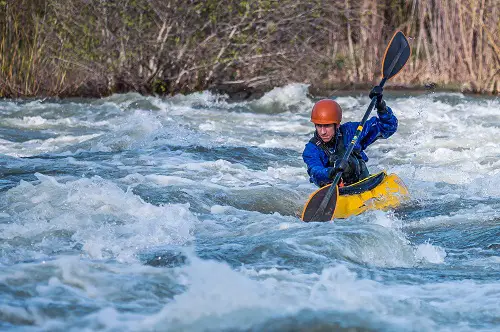
Don’t Forget Safety Gear.
Finding and bringing the right equipment is a big part of the preparation for your kayaking trip. It’s even more crucial if you’re alone in the water. Since nobody will be there to help you, the gear you have might save your life.
That’s why you should always wear your PDF, dress for immersion, and take any other necessary precautions. For example, putting on a helmet and spray skirt is a must if you kayak in a river.
Tell Someone Where You Go Kayaking.
If your journey doesn’t end as you plan, a trusted person should know your location. This person must also have an idea of how long you go there. He could then find and help you or give that information to the rescue services if needed.
You can also create an emergency plan with this person if you want to be ready for any situation. That’s where the communication device and other accessories might become essential. Prevention is always better than cure.
Start With An Easy & Short Adventure.
Like for anything else, you should begin slowly but surely. Kayaking alone is always a challenge in itself, so don’t make things complicated. Your first solo trips should be as easy and short as possible to avoid problems.
Once you have more experience and confidence, feel free to increase the difficulty of your paddling adventures. Safe doesn’t mean boring. Just make sure to respect your limits and don’t put yourself in danger for no reason.
Be Aware Of The Risks.
As I already told you, kayaking alone is more dangerous than paddling with a group. But it doesn’t mean you shouldn’t do it. Solo trips can be fun and safe if you understand the risks involved and have the proper skills to avoid them.
Otherwise, you can always learn with others until you feel all set to paddle on your own. Your level of awareness must be well developed when you have to rely on yourself only. It’s impossible to keep you safe if you don’t know what can be harmful.
Learn more about the kayaking risks!
Have Fun, But Stay Careful!
With that said, too much worrying isn’t good either. Kayaking alone shouldn’t take the fun out of the sport. This activity can be enjoyable whether you have company or not.
As long as you are well prepared to paddle on your own and do it cautiously, everything should be alright. So I don’t have any problem with solo adventures if they are safe and fun.
Last Thoughts About Kayaking Alone!
Finally, you don’t always need someone to paddle with on the water. You can enjoy solo kayaking safely if you have enough knowledge and experience in this water sport. It’s also essential to gear up properly and take precautions to avoid unnecessary risks.
Total beginners should learn from other paddlers before going out on their own. Without proper skills, kayaking alone might not be a good idea. But I would recommend giving it a try if you feel like you’re ready to stand on your own two feet.
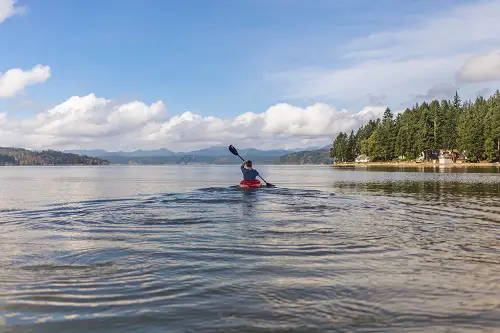
I hope my article has helped you understand what it takes and how to kayak without any partner. Now it’s time to improve your paddling skills and prepare for your next (or maybe first) solo trip.
See You On The Water & Have Fun!
